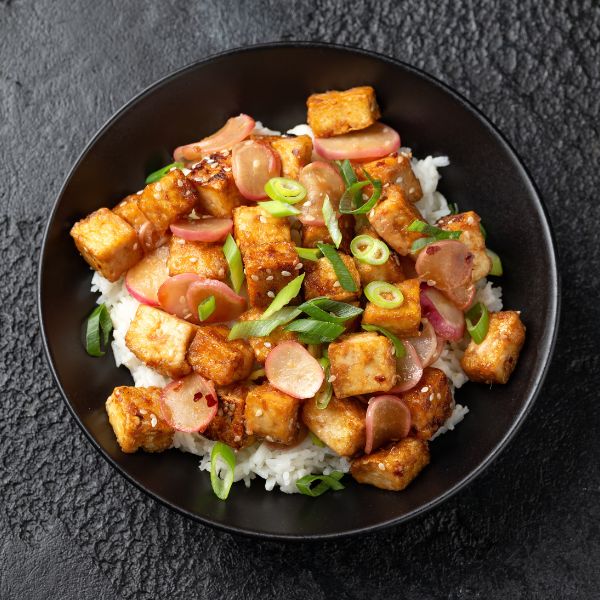 Tofu was one of the first meat alternatives in American diets, introduced toward the middle of the 20th century. Yet this vegetarian staple, made from curdled and pressed soybean milk, has been used in Asian diets for centuries, with origins as far back as 950 A.D. in China.
Tofu was one of the first meat alternatives in American diets, introduced toward the middle of the 20th century. Yet this vegetarian staple, made from curdled and pressed soybean milk, has been used in Asian diets for centuries, with origins as far back as 950 A.D. in China.
Today, the U.S. market includes multiple types of tofu that have potential to substitute various meat and dairy products. Here’s what you should know.
What Is Tofu?
Tofu is produced similarly to cheese. Soybeans are first soaked and ground, then cooked and strained. Soy milk is boiled until it curdles then pressed into blocks, using nigari as a coagulant and stabilizer.
Cooking time determines how firm the blocks of tofu will be. While 15 to 20 minutes is the average, anything less results in a softer, almost spreadable silken tofu. More time gets rid of whey and water content to create a firmer texture.
Based on firmness, tofu can be baked or fried until it resembles a creamy liquid. Softer tofu types tend to contain more water, while firmer options have a higher protein content. In terms of preparation, firmer tofu typically requires more cooking time.
Silken Tofu
Silken is an undrained, unpressed Japanese tofu with a higher water content that’s created with little to no curdling. Without any preparation, some describe it as “custardy”. Cooking helps break down the tofu, so it becomes softer and creamier. For vegan cooking, the result is ideal for baking, puddings, sauces and smoothies, often substituting eggs or dairy.
Silken tofu is fairly delicate, wobbly and crumbly, which is not ideal for frying. This form has two subtypes: fresh or soft silken tofu, which is also called “custard tofu” and firm silken, which uses a thicker soymilk and contains less water. For preparation, you’re advised to use silken tofu as soon as possible after opening the package.
Soft Tofu
The most pliable of “regular” tofu types, soft has a dense yet still light and spongy texture with some moisture content. While silken tofu has Japanese origins, soft tofu is more common in Chinese cooking and can be used in a similar fashion, from savory dishes to desserts. Unless breaded first, soft tofu is not recommended for frying.
Medium Tofu
Medium tofu falls in between the softer, crumbly silken texture and the denser firm variety, due to a moderate moisture content. This form is ideal for savory dishes, from stir fries and vegan scrambled eggs to braising, boiling and light frying.
Firm Tofu
The most commonly used tofu in the U.S., firm has the density to be stir-fried with ease, yet can also be crumbled, making it an ideal substitute for scrambled or hardboiled eggs and ricotta. The firmer, more solid texture can also be stuffed without falling apart.
Extra and Super-Firm Tofu
Extra and super-firm tofu types can be sliced and cubed without crumbling. These attributes make them ideal for stir, pan and deep frying, as well as baking, broiling, grilling and used in place of ground beef.
However, the denser texture is less likely to absorb the other flavors of your recipe. Instead, you’re recommended to fry or broil it ahead of time to improve absorbency.
Other Tofu Types
Beyond these basics, other forms of tofu include:
- Tofu Skin: Fresh or dried, skins have a crinkly, somewhat tough texture that can be added to soups or used for sushi.
- Tofu Puffs: Pre-fried, tofu puffs come in cube and slice formations and can be added to your recipe with no preparation.
- Fermented: Also called “fu ru,” this tofu is packaged in brine and yeast for a more distinctive, pickled flavor. The tofu may offer some spread-ability.
- Dofu: This prepared tofu may be pre-seasoned with soy sauce and Chinese spice powder and can be added directly to your recipe.
- Tofu Noodles: This low-calorie, protein-packed alternative to carbohydrate varieties can be stir-fried with sauces or added to soup as a noodle substitute.
Explore all possibilities with tofu at Colony Diner! Browse our vegan menu, then visit our Wallingford restaurant to try this versatile meat alternative.






